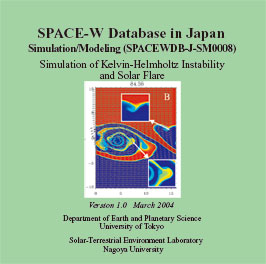Database in Japan
Observation (SPACEW-J-SM0008)
Version 1.0 March 2004
(CAWSES database in Japan)
Simulation of Kelvin-Helmholtz Instability and Solar Flare

SM0008
| SPACE-W (Space Weather International Collaborative Research) Database in Japan Observation (SPACEW-J-SM0008) Version 1.0 March 2004 (CAWSES database in Japan) Simulation of Kelvin-Helmholtz Instability and Solar Flare |
 SM0008 |
<<Non-linear evolutions of the Kelvin-Helmholtz instability in stratified shear layers>>
Yosuke Matsumoto and Masahiro Hoshino
Department of Earth and Planetary Science, University of Tokyo.
Abstract
A two-dimensional MHD simulation of the Kelvin-Helmholtz (K-H) instability in a stratified shear layer shows a strong development of turbulence through non-linear instabilities. The difference in density between the two media plays a crucial role on the fast turbulent mixing and transport. The onset of the turbulence is triggered not only by secondary K-H instability but also by Rayleigh-Taylor (R-T) instability at the density interface inside the normal K-H vortex, whose onset mechanisms are attributed to the centrifugal force of the rotating motion. The secondary R-T instability alters the macroscopic structure by transporting dense fluids to tenuous region, while the secondary K-H instability is just a seed for the turbulence. The onset mechanism and the formation of the broad mixing layer give a new understanding of the mixing process in a variety of geo- and astrophysical phenomena.
Summary
Two-dimensional MHD simulations of the Kelvin-Helmholtz instability have shown that the inhomogeneity in fluid induces turbulence and enhances the mixing of the two media. The triggers of the onset are the secondary K-H and the Rayleigh-Taylor instabilities which grow inside the normal K-H vortex. Furthermore, the R-T instability also plays an important role in the mass transport to tenuous regions while the secondary K-H instability is just a seed for the turbulence. Although these two secondary instabilities themselves are classical, the excitation of secondary instabilities, in particular, the R-T instability by the rotating motion of a normal K-H instability is a new concept. Once the onset is triggered, turbulence is generated since the subsequent higher order instabilities are induced by the pre-excited K-H and R-T instabilities. This chain-reaction continues until the dissipation overcomes the instabilities. The mechanism is therefore a strong non-linear coupling. In space and astrophysical phenomena there is also a magnetic field interface where there is a velocity shear interface. To elucidate the effect of inhomogeneity in the magnetic field (thermal pressure) on the non-linear development we have also carried out the simulation of an inhomogeneous transverse magnetic field case maintained by inhomogeneous temperature fluids with a homogeneous density profile. As a result, no development of turbulence is confirmed and we conclude that inhomogeneities in the magnetic field are not important for the onset of turbulence in a ideal MHD regime, even though kinetic approaches are required for a more appropriate expression. The results presented here and what we suggest are significant in a variety of fields, since the density interface with a velocity shear are observed in plenty of natural phenomena. In particular, the present mechanism, which is fundamentally hydrodynamic, well explains the formation of the broad mixing layer lying in the low latitude region of the earth's magnetosphere, providing a new understanding of the Sun-Earth connection model from the view point of the transport of solar wind plasma into the earth's magnetosphere.
Contact:
Yosuke Matsumoto and Masahiro Hoshino
Department of Earth and Planetary Science,
University of Tokyo
7-3-1 Hongo, Bunkyo, Tokyo 113-0033
Tel:+81-3-5841-4584 Fax:+81-3-5841-8321
ymatumot[AT]eps.s.u-tokyo.ac.jp
hoshino[AT]eps.s.u-tokyo.ac.jp
<<MHD Simulation of a Solar Flare Based on Magnetic Reconnection Model>>
Yokoyama, T. & Shibata, K.
National Astronomical Observatoy of Japan
Abstract
Two-dimensional simulation of a solar flare is performed using a newly developed magnetohydrodynamic (MHD) code including nonlinear anisotropic heat conduction effect . We also derived a simple scaling law for the flare temperature described as T \propto B^{6/7} where T and B are the temperature at the flare loop apex and the coronal magnetic field strength.
Contact:
Takaaki Yokoyama
Department of Earth and Planetary Science,
University of Tokyo
7-3-1 Hongo, Bunkyo, Tokyo 113-0033
Tel:+81-3-5841-4591 Fax:+81-3-5841-8791
yokoyama.t[AT]eps.s.u-tokyo.ac.jp